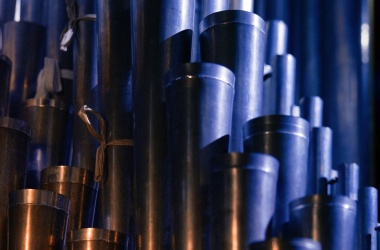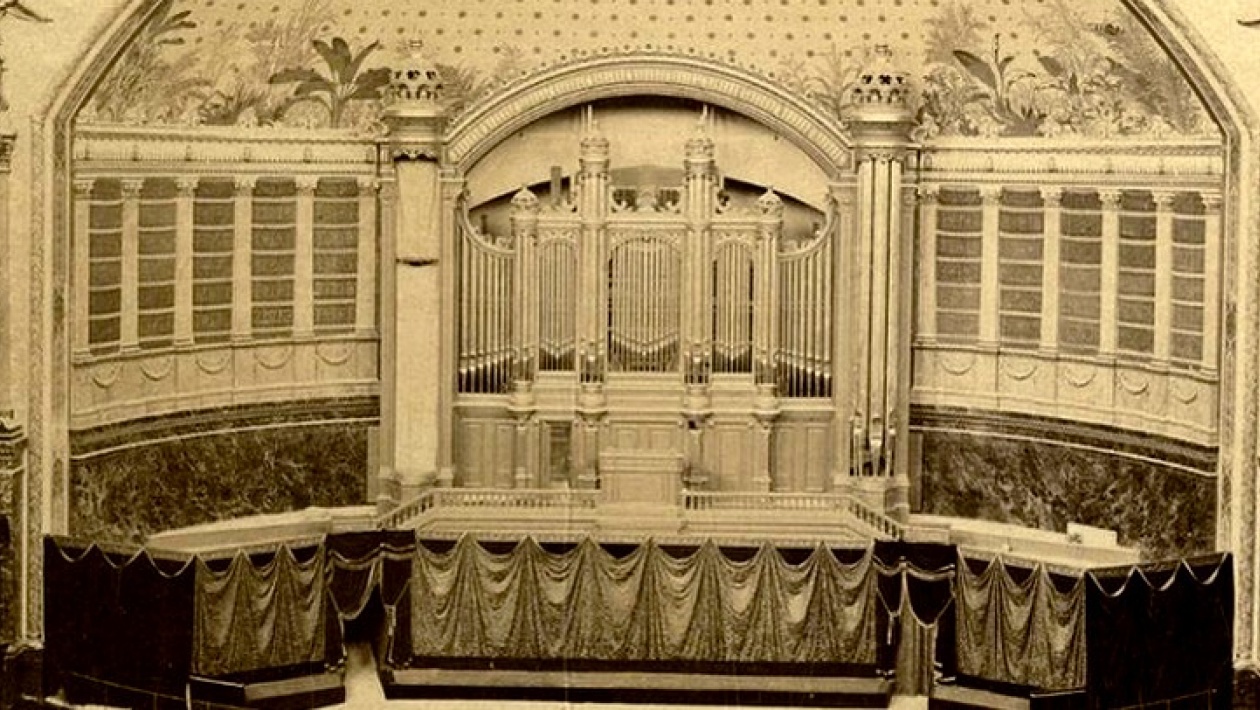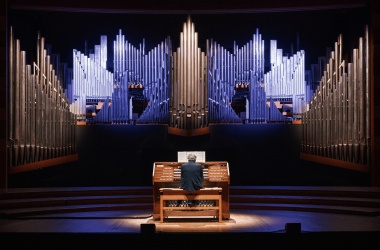
The Palais du Trocadéro: a “republican cathedral”
Situated opposite the Champ-de-Mars, and providing a spectacular view of the military parades taking held there, the Chaillot hill (Paris) stirred the lust of power after the Revolution, during which the convent founded in 1651 by Henriette-Marie de France was destroyed. In 1811, a month before the birth of his son, the King of Rome, Napoleon I decided to build a sumptuous palace there as a home for his heir. When the Empire fell, only some of the earthworks had been completed. A succession of grandiose projects followed. In 1867, Napoleon III had the ground levelled to give the crowd a clear view over the Exposition universelle (World’s Fair) held on the Champ-de-Mars.
After the fall of the Second Empire and the uncertain beginnings of the Third Republic, 1875 ushered in a period of political stability. The period lent itself to festivities and plans were made for a new World’s Fair in 1878, bigger and more sumptuous than ever before. The Champ-de-Mars was no longer big enough, so it was decided to build a monumental palace on the Chaillot hill, on a square called the place du Roi-de-Rome and renamed place du Trocadéro in the meantime to commemorate Louis XVIII’s victory in front of the Spanish fort of the same name.
Gabriel Davioud was commissioned to design the building. Framed by two enormous wings, the neo-Byzantine edifice houses an immense Salle des fêtes (Festival Hall) that can accommodate 5,000 people. Meanwhile, Mac-Mahon’s win in the 1877 elections had firmly established the Republic. Right from its inauguration on 1 May 1878, the Palais du Trocadéro was intended to be a popular success: the government granted the workers a day’s holiday so they could take part in the celebrations.
The palace retained this role even after the World’s Fair and, in the end, was not demolished after the festivities as originally planned. Museums were installed in the wings and the vast reception room housed immense gatherings, such as school children, masonic ceremonies, choirs, charity events, war veterans’ gatherings and national lottery draws. The reception room became the new Republic’s lay cathedral. There is no Christ in Majesty here presiding over the buffet, but a gigantic bust of Marianne (the national personification of the French Republic) towering over a console frequently dressed with flags. This is the setting in which, on 14 July 1890, the centenary of the celebration of the Federation and the first French national holiday were celebrated.
The arts also have their home here: music, first of all, around the organ, followed by theatre, since Firmin Gémier founded the Théâtre national populaire (TNP) there in 1920. Both the organ and the theatre are completely in keeping with the spirit of the place: the instrument built by Cavaillé-Coll – the second secular organ of such importance after the one in Birmingham (1834) – by developing a whole concert repertoire; the TNP by opening up this art to as many people as possible.
In 1935, the Palais du Trocadéro was demolished to make way for the Palais du Chaillot, built to house the “International Exhibition of Art and Technology in Modern Life” in 1937.
An organ for the 1878 World’s Fair
When the plan to build the Palais du Trocadéro first emerged, it was soon decided to build an organ there. The goal was to forget the indignity of the 1867 World’s Fair, when the American company Steinway snatched the Grand Prize for Musical Instrument Manufacturing from under the nose of the great French piano-makers, Érard, Gaveau and Pleyel. The construction of the organ was entrusted to the most reputed French organ builder of the time: Aristide Cavaillé-Coll. The latter already had some experience of building concert organs, including those in Sheffield (1873) and in the Palais de l’Industrie in Amsterdam (1875).
Pressed for time, he repurposed the pipes of a three-manual organ that he had just finished building and which was originally intended for the new Notre-Dame-d’Auteuil church, just a short distance from the Trocadéro. According to the musicologist Rollin Smith, however, the instrument was originally designed not for this church (which was still on the drawing board) but for an unknown client who subsequently went back on his decision. It would appear, though, that the priest, Abbé Lamazou, took advantage of the instrument’s availability to buy it at a reduced price for his new place of worship.
Whatever the circumstances, Cavaillé-Coll had to adjust the instrument to the huge Salle des fêtes. He increased the number of manuals from three to four, the number of stops from 45 to 66 and used powerful stops to compensate for the relative lack of reverberation in the acoustics. The organ is one of the largest of its time and incorporates the latest technical advances, such as Barker machines (pneumatic assistance mechanisms that reduce the manuals’ mechanical resistance and paved the way for the development of symphonic pipe organs), wind system producing highly differentiated pressures and capable of meeting the substantial wind requirements, and combination action system.
The style is resolutely Romantic and symphonic, swapping the many standard mutation stops and mixture stops for a wealth of 8’ stops, additional low-pitched stops (16’ and 32’) and a large number of stops specific to the “symphonic” organ, such as undulating stops (Voix céleste, Unda maris), Cellos, Gambas, Diapasons, Clarinet, Harmonic Flutes, etc. Moreover, two manuals are expressive (Positif and Récit), which is new for the times.
Cavaillé-Coll held private demonstrations of the organ in his workshop, which were enormously popular.
Mr Arthur Pougin, the Journal officiel’s new musical editor, reports on a very interesting public demonstration of the Trocadéro organ held the previous Sunday in Mr Cavaillé-Coll’s workshops. Over 500 people attended. Mr Guilmant, the highly respected organist at the Trinité church, did the honours at the new instrument and was warmly congratulated by Mr Gounod and Saint-Saëns, among others.
Le Ménestrel, 21 April 1878
In the competition organised for the World’s Fair, Cavaillé-Coll received the Grand Prix for his organ in category 13, for musical instrument manufacturing; Franz Liszt was on the jury. This distinction earned the organ builder a promotion to the rank of Officer of the Légion d’honneur (Journal officiel dated 24 October 1878).
Inaugural concerts
The first concert at the Trocadéro took place on 6 June 1878. Édouard Colonne conducted a 350-member orchestra in Le Désert by Félicien David and the cantata Les Noces de Prométhée by Camille Saint-Saëns. The organ was inaugurated on 7 August 1878 by Alexandre Guilmant, who played his Marche funèbre et Chant séraphique, along with pieces by Lemmens, Martini, Chauvet, Handel, Bach (Toccata and Fugue in D minor, BWV 565) and Mendelssohn. From then on, Guilmant acted as the incumbent organist – even if he was never officially awarded the title.
It was he who organised the series of 16 concerts that launched the instrument’s history. Up until 8 October, the greatest organists played the new organ, including Eugène Gigout (13 August), Théodore Dubois (21 August), Camille Saint-Saëns (28 September) and André Messager (8 October). On 22 August, two weeks after the inaugural concert, Guilmant returned for the world premiere performance of his First Symphony for Organ and Orchestra – which is an orchestration of his First Sonata for Organ composed in 1875.
On 1 October, the Trocadéro hosted César Franck, who played his Three Pieces, which were composed for the occasion. Alongside the official series, Jacques-Nicolas Lemmens and his wife, Helen Lemmens-Sherrington, who happened to be in Paris at the time, gave a special concert in September, accompanied by Guilmant and the flautist Paul Taffanel.
However, the highlight was perhaps the recital by Charles-Marie Widor on 24 August, giving the first performance of his Sixth Symphony. The Trocadéro organ built by Cavaillé-Coll, archetype of the “symphonic”, was particularly well suited to performing a symphony for solo organ, where its rich tones and sheer power were a match for any orchestra.
THE FINEST HOURS OF THE TROCADÉRO ORGAN
The World’s Fair ended on 31 October 1878. The following summer, Guilmant initiated a concert series mixing solo organ and organ accompanied by other instruments, notably an orchestra. This is how, on 19 October 1879, Widor came to give the first public performance of his Fifth Symphony, crowned by the renowned “Toccata” (a few weeks earlier, in June, the Lyon-born organist had played one of his two new symphonies for solo organ, the Fifth or the Sixth – or both – at a private concert for the Minister of Fine Arts). During the World’s Fair of 1889, Widor presented a third symphony, the Eighth, at the Trocadéro. On 11 June 1896, he conducted his Third Symphony for Organ and Orchestra, Op. 69, with his pupil, Louis Vierne, as soloist.
After this glorious beginning, problems soon arose. The parish priest from Notre-Dame d’Auteuil wanted his pipes back. Thanks to Guilmant and Widor, the French State purchased the organ in 1882 for the Trocadéro. Cavaillé-Coll built an instrument for Auteuil with two manuals and 32 stops, which was inaugurated on 11 February 1885. The festival hall’s acoustics proved disastrous for any form of music other than the organ. As a result, it gradually came to host only organ concerts, with or without an orchestra. The greatest French, European and even American organists helped make the Palais du Trocadéro a venue that was admired the world over. Large-scale works were also performed there, such as Gounod’s Gallia, La Rédemption and Mors et Vita oratorios, Handel’s Messiah or the world premiere performance of the concert version of Fauré’s Requiem (1900).
Right from the inaugural concerts, Guilmant made a point of promoting the early music repertoire. To his ears, Cavaillé-Coll’s organ, despite its profoundly Romantic colours, was perfectly suited to the works of Bach, Buxtehude, Frescobalid and others, whether or not the pieces in question were originally written for organ. On 9 September 1889, he gave a famous Concert historique (Historical Concert), the scores of which he later published. Airs by Rameau, Cesti and Monteverdi and pieces by Byrd, Muffat and Clérambault were followed by more recent works, such as the charming Andante con moto by his elder, Boëly, who, from his tribune in Saint-Germain-l’Auxerrois, had preceded him in introducing Parisians to the music of the Old Masters.
Guilmant published another four volumes of his own transcriptions of early works, under the title Répertoire du Trocadéro. They include two adaptations for solo organ of Handel’s Concertos for Organ and Orchestra (all of which he had previously performed at the Trocadéro), along with the Rondeau Sœur Monique by François Couperin and the celebrated Sinfonia from Bach’s Cantata BWV 29.
Decline
At the beginning of the twentieth century, the organ – which was in sore need of funding – was struck by increasingly frequent mechanical problems. Guilmant’s death in 1911, then the war, further complicated matters. In 1920, Camille Saint-Saëns nevertheless scored a triumph with the first performance in France of Cyprès et Laurier, in which Gigout played the solo organ part.
That same year, Marcel Dupré achieved an unprecedented exploit: he played Bach’s complete organ works, by heart, in ten concerts (before attempting the feat at the Trocadéro, where the rental fees were high and the concert hall immense, he had given a very conclusive initial performance in the more modest concert hall of the Conservatoire).
In spring, Dupré gave a series of six recitals, performing a combination of works by the great masters and his own. Nonetheless, the instrument was in a very worrying state and Louis Vierne was among those touched by its plight. On 30 April 1925, Dupré gave the French premiere performance of his Symphonie-Passion for an enthusiastic audience of 3,000, but was dismayed by the organ’s disastrous deterioration.
In 1926, after succeeding Eugène Gigout as organ teacher at the Conservatoire, Dupré leveraged this additional prestige to set up an organ support committee with the help of his teacher, Widor, and raise funds with his colleagues’ support. He gave a benefit recital and also drew on his own funds. Once the funds had been raised, he supervised the renovation and inaugurated the restored instrument on 11 March 1927. Dupré performed there another half-dozen times, including the first performance of the Chemin de la Croix on 14 August 1932 (a transcription of the 14 improvisations on the stations in the poem of the same name by Paul Claudel). He gave a farewell concert there on 14 August 1935, before the instrument was dismantled and the building demolished.
– Claire Delamarche
The instrument
– 4 manuals, each with 56 notes (Grand-Orgue, enclosed Positif, enclosed Récit, Solo)
– 30-note pedal keyboard
– 66 stops in 85 ranks
– Differentiated wind pressures within each division to achieve a balanced sound (Petite Pédale/Grande Pédale/32’ division on the Pedal, foundation stops/reed stops division on the Grand-Orgue, bass/treble division on the Solo)
– Mechanical traction with two Barker levers

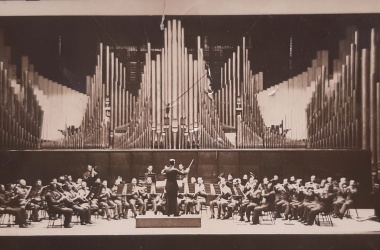
1939: Palais de Chaillot
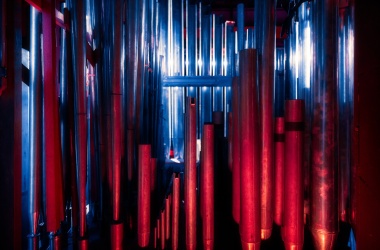
1977: Auditorium de Lyon
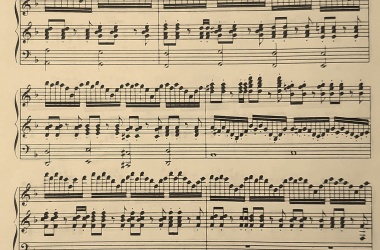
The works premiered on the instrument
